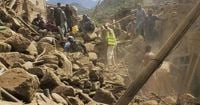In the pre-dawn hours of Sunday, August 31, 2025, eastern Afghanistan was jolted awake by a powerful magnitude 6.0 earthquake, flattening villages, trapping families beneath the rubble, and plunging already struggling communities into a new crisis. By Tuesday, September 2, the death toll had soared past 1,400, with more than 3,000 people reported injured, according to the Taliban government’s spokesperson Zabihullah Mujahid, as cited by multiple news agencies including Reuters and AFP.
But the nightmare didn’t end there. As survivors in remote, mountainous regions like Kunar and Nangarhar provinces braced themselves for another night under the open sky, a series of strong aftershocks—including a magnitude 5.5 quake on Tuesday—rattled the same devastated area, sparking fears of further destruction and complicating rescue efforts. The US Geological Survey confirmed at least six aftershocks, including a 5.2-magnitude tremor near Sunday’s epicenter, which was about 27 kilometers from Jalalabad and just eight kilometers below the Earth’s surface—a shallow depth that amplifies seismic destruction.
The scale of devastation is staggering. In Kunar province alone, more than 5,400 houses were destroyed, leaving thousands without shelter. “There is no food... there is nothing, everything has been buried in the rubble,” Nurgal district official Ijaz Ulhaq Yaad told AFP, describing how residents—including children and the elderly—were left exposed to wet weather, with little protection or supplies. The situation is so dire that aid agency Save the Children reported its teams had to walk 20 kilometers, carrying medical equipment on their backs, to reach isolated villages cut off by rock falls and damaged roads.
The United Nations has sounded the alarm over a potential exponential rise in casualties. Indrika Ratwatte, the UN’s resident coordinator for Afghanistan, warned in a Geneva briefing, “We cannot afford to forget the people of Afghanistan who are facing multiple crises, multiple shocks, and the resilience of the communities has been saturated.” He added, “These are life and death decisions while we race against time to reach people.” The UN released $5 million from its emergency fund, matched by another $5 million from the Afghanistan Humanitarian Fund, to jumpstart relief efforts. At least 25 assessment teams have been dispatched, delivering essentials like blankets and solar lamps where access is possible.
Yet, the challenges facing rescuers and survivors alike are immense. The rough, mountainous terrain has forced Taliban authorities to air-drop commandos to evacuate the injured from areas where helicopters can’t land. Many roads remain blocked by landslides, though Yousaf Hammad, spokesperson for Afghanistan’s National Disaster Management Authority, said some have been reopened to enable aid to reach the hardest-hit communities. Still, as the hours tick by, the window for finding survivors narrows.
Most casualties have been recorded in Kunar province, where steep river valleys and high mountains make access treacherous. The earthquake struck while most people were asleep, a factor that likely increased the number of deaths and injuries, as mud-brick and wooden homes collapsed on their occupants. As the Associated Press reported, “Mud brick homes that were unable to withstand the shock crumbled, trapping thousands of people.”
Experts have pointed to poor construction as a key factor behind the heavy loss of life. According to coverage from multiple outlets, many of the houses in the affected areas were built with little regard for earthquake resistance—a tragic vulnerability in a region prone to seismic activity. Afghanistan has suffered similar disasters in recent years: a 6.3-magnitude quake in Herat province in October 2023 killed more than 1,500 people and damaged or destroyed over 63,000 homes, while a 5.9-magnitude quake in Paktika province in June 2022 killed over 1,000 people and left tens of thousands homeless.
The humanitarian response has been hampered by more than just geography. Afghanistan’s healthcare system, already battered by years of conflict and dwindling international aid, is now stretched to the breaking point. Kate Carey, deputy head of the UN Office for the Coordination of Humanitarian Affairs in Afghanistan, noted that more than 420 health facilities have closed or suspended operations due to funding cuts, with 80 closures in the eastern region alone—directly impacting the quake zone. “The consequence is that the remaining facilities are overwhelmed, have insufficient supplies and personnel, and are not as close to the affected populations as the more local facilities at a time when providing emergency trauma care is needed in the first 24 to 72 hours of the earthquake response,” Carey said.
This earthquake is the third major one to strike Afghanistan since the Taliban returned to power in 2021, and it comes as the country faces a cascade of challenges: a weak economy, millions of people forcibly returned from Iran and Pakistan, and deep cuts to aid funding. The Taliban-led government, recognized only by Russia, has appealed for international assistance. The UK has pledged £1 million in aid, to be distributed through humanitarian agencies rather than the Taliban government, which London does not recognize. China and other countries have also offered support for disaster management.
Yet, the international response has been complicated by political realities. Many donor countries have scaled back their funding, partly in response to the Taliban’s restrictive policies on Afghan girls and women, including a ban on them working for NGOs. As a result, help for Afghanistan is in short supply even as the need grows. Mark Calder of World Vision Afghanistan warned that more than 250,000 people are expected to “swell the ranks” of those in need of basic assistance, including shelter, food, and clean water. “This means more people living without proper shelter, without access to food for their families and clean water, and malnutrition and disease in a situation where the health care system simply doesn’t have the capacity anymore,” he said.
Despite the odds, rescue teams—both local and international—continue to search for survivors. Helicopters evacuate the injured when possible, and aid workers traverse hazardous terrain on foot. But as aftershocks continue to rattle the region and the full extent of the disaster comes into focus, the people of Afghanistan face a long and uncertain road to recovery. The world watches, hoping that help can arrive in time for those who need it most.





